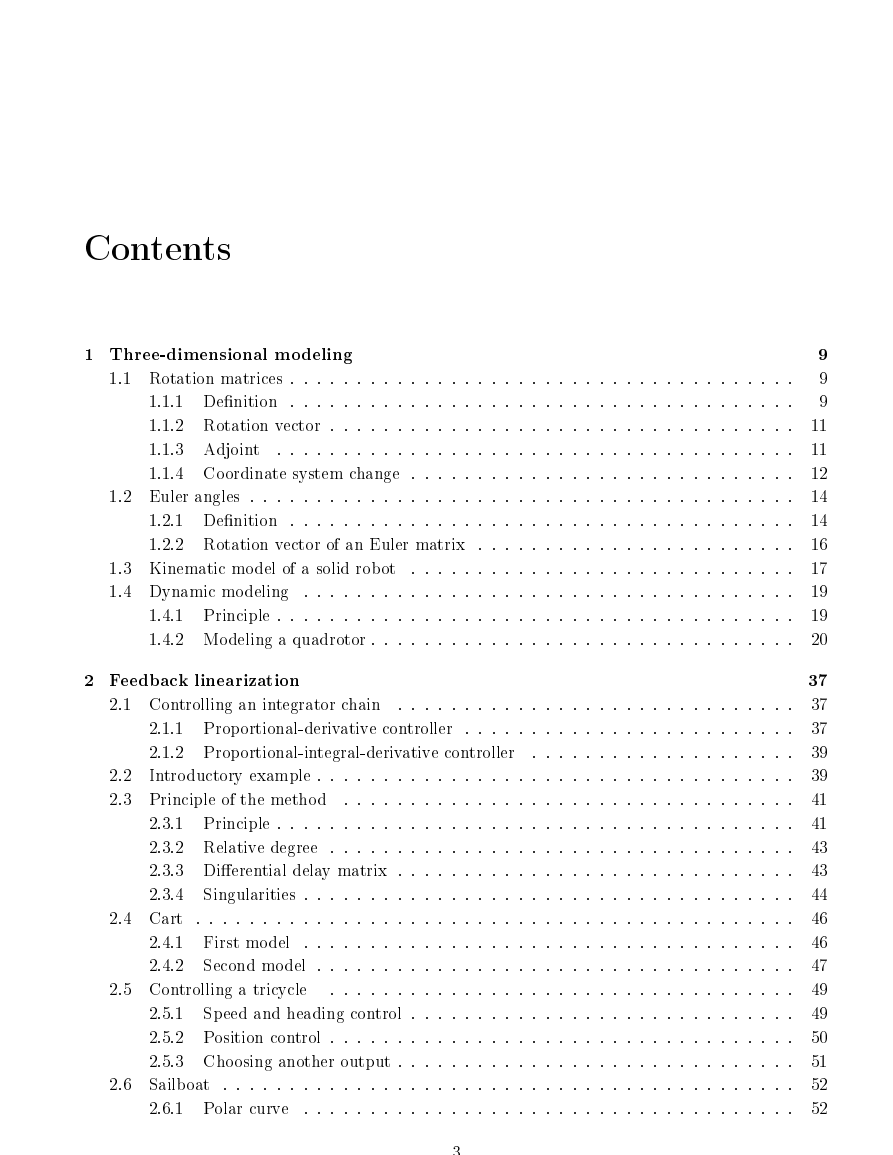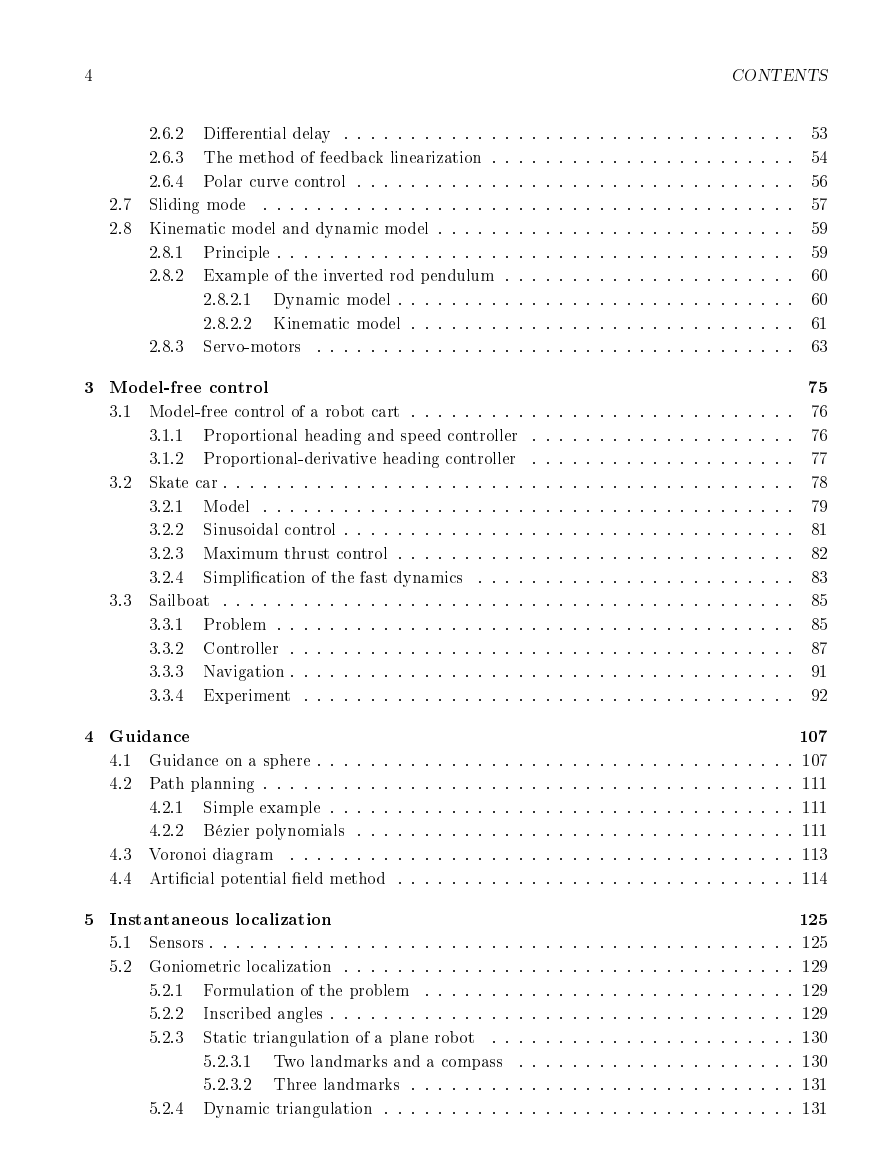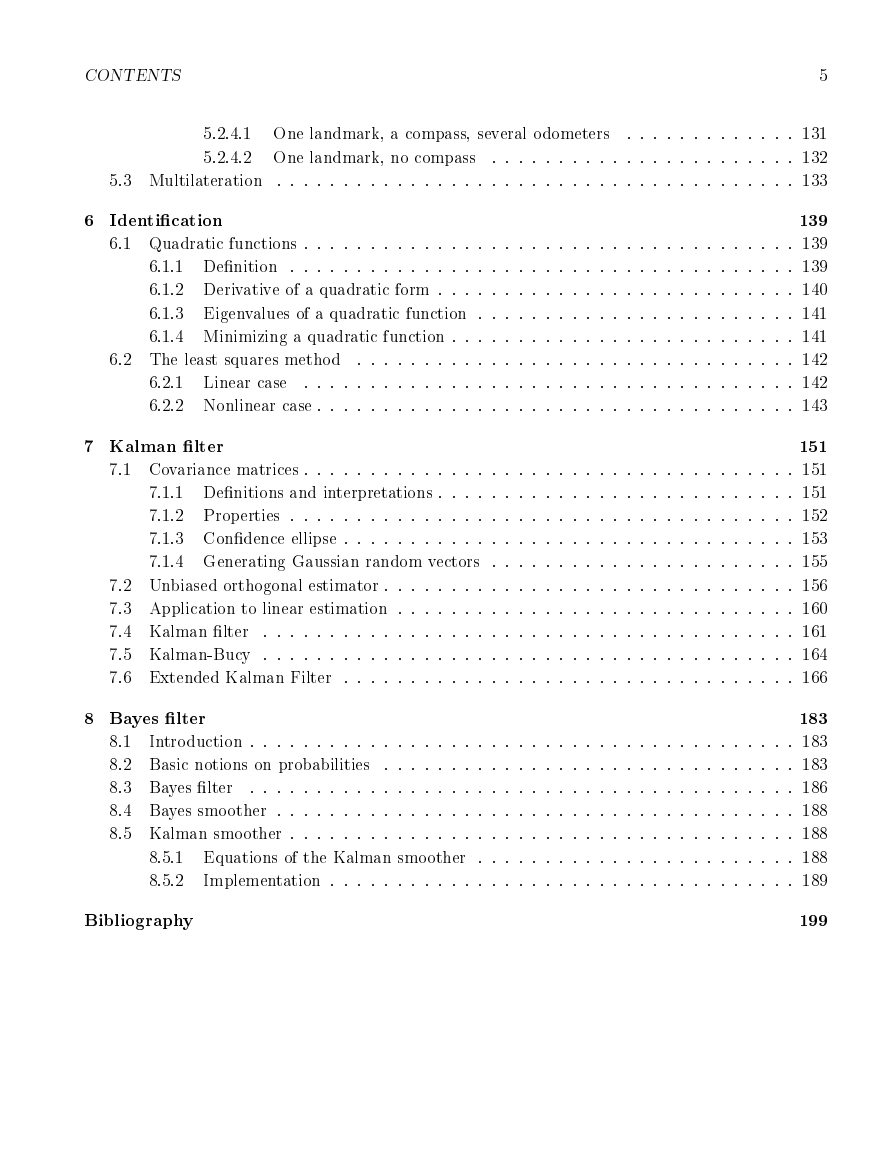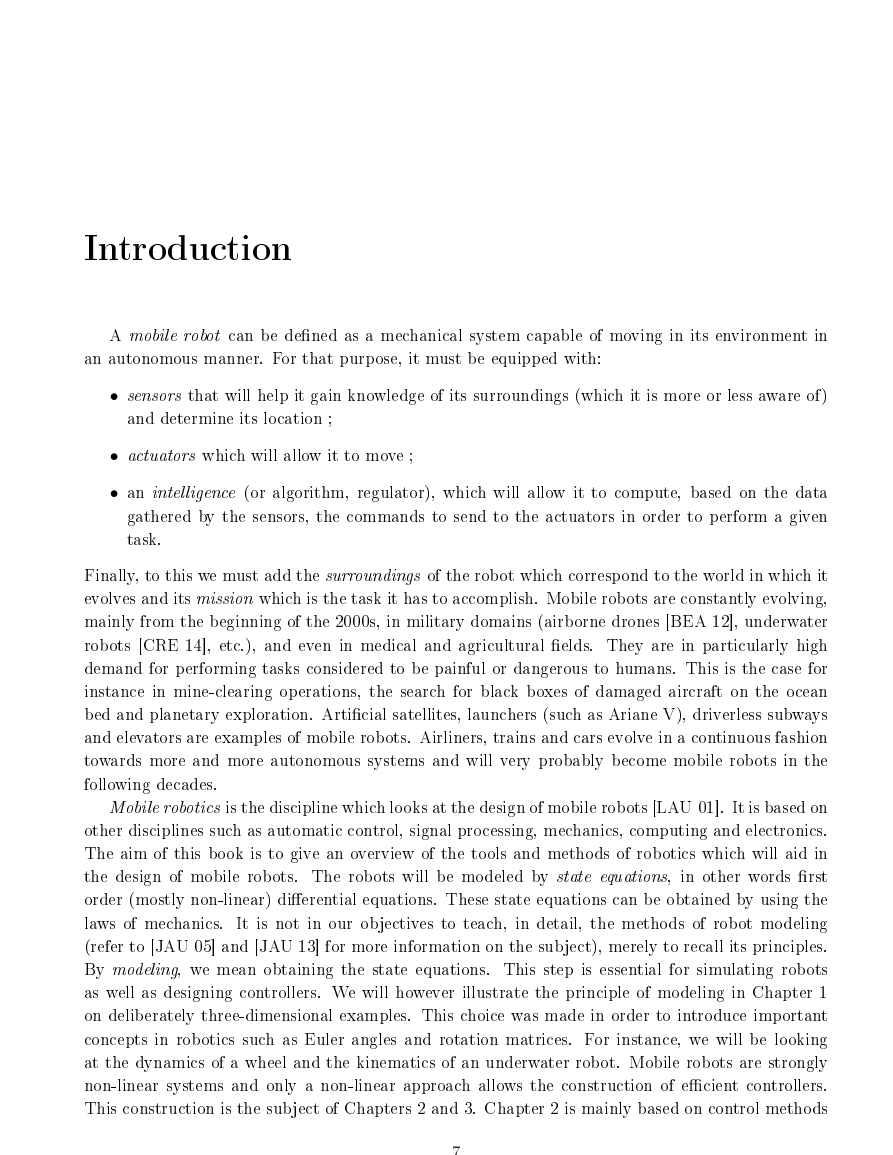Mobile robotics
Luc Jaulin
June 28, 2018
�
2
�
Contents
1 Three-dimensional modeling
1.1 Rotation matrices . . . . . . . . . . . . . . . . . . . . . . . . . . . . . . . . . . . . . .
1.1.1 De�nition . . . . . . . . . . . . . . . . . . . . . . . . . . . . . . . . . . . . . .
1.1.2 Rotation vector . . . . . . . . . . . . . . . . . . . . . . . . . . . . . . . . . . .
1.1.3 Adjoint
. . . . . . . . . . . . . . . . . . . . . . . . . . . . . . . . . . . . . . .
1.1.4 Coordinate system change . . . . . . . . . . . . . . . . . . . . . . . . . . . . .
1.2 Euler angles . . . . . . . . . . . . . . . . . . . . . . . . . . . . . . . . . . . . . . . . .
1.2.1 De�nition . . . . . . . . . . . . . . . . . . . . . . . . . . . . . . . . . . . . . .
1.2.2 Rotation vector of an Euler matrix . . . . . . . . . . . . . . . . . . . . . . . .
1.3 Kinematic model of a solid robot
. . . . . . . . . . . . . . . . . . . . . . . . . . . . .
1.4 Dynamic modeling . . . . . . . . . . . . . . . . . . . . . . . . . . . . . . . . . . . . .
1.4.1 Principle . . . . . . . . . . . . . . . . . . . . . . . . . . . . . . . . . . . . . . .
1.4.2 Modeling a quadrotor . . . . . . . . . . . . . . . . . . . . . . . . . . . . . . . .
2 Feedback linearization
2.1 Controlling an integrator chain . . . . . . . . . . . . . . . . . . . . . . . . . . . . . .
2.1.1 Proportional-derivative controller . . . . . . . . . . . . . . . . . . . . . . . . .
2.1.2 Proportional-integral-derivative controller
. . . . . . . . . . . . . . . . . . . .
2.2
Introductory example . . . . . . . . . . . . . . . . . . . . . . . . . . . . . . . . . . . .
2.3 Principle of the method . . . . . . . . . . . . . . . . . . . . . . . . . . . . . . . . . .
2.3.1 Principle . . . . . . . . . . . . . . . . . . . . . . . . . . . . . . . . . . . . . . .
2.3.2 Relative degree . . . . . . . . . . . . . . . . . . . . . . . . . . . . . . . . . . .
2.3.3 Di�erential delay matrix . . . . . . . . . . . . . . . . . . . . . . . . . . . . . .
2.3.4
Singularities . . . . . . . . . . . . . . . . . . . . . . . . . . . . . . . . . . . . .
2.4 Cart . . . . . . . . . . . . . . . . . . . . . . . . . . . . . . . . . . . . . . . . . . . . .
. . . . . . . . . . . . . . . . . . . . . . . . . . . . . . . . . . . . .
. . . . . . . . . . . . . . . . . . . . . . . . . . . . . . . . . . . .
. . . . . . . . . . . . . . . . . . . . . . . . . . . . . . . . . . .
2.5.1
. . . . . . . . . . . . . . . . . . . . . . . . . . . . .
2.5.2 Position control . . . . . . . . . . . . . . . . . . . . . . . . . . . . . . . . . . .
2.5.3 Choosing another output . . . . . . . . . . . . . . . . . . . . . . . . . . . . . .
2.6 Sailboat . . . . . . . . . . . . . . . . . . . . . . . . . . . . . . . . . . . . . . . . . . .
2.6.1 Polar curve . . . . . . . . . . . . . . . . . . . . . . . . . . . . . . . . . . . . .
Second model
2.5 Controlling a tricycle
2.4.1 First model
2.4.2
Speed and heading control
9
9
9
11
11
12
14
14
16
17
19
19
20
37
37
37
39
39
41
41
43
43
44
46
46
47
49
49
50
51
52
52
3
�
4
CONTENTS
2.6.2 Di�erential delay . . . . . . . . . . . . . . . . . . . . . . . . . . . . . . . . . .
2.6.3 The method of feedback linearization . . . . . . . . . . . . . . . . . . . . . . .
2.6.4 Polar curve control
. . . . . . . . . . . . . . . . . . . . . . . . . . . . . . . . .
2.7 Sliding mode
. . . . . . . . . . . . . . . . . . . . . . . . . . . . . . . . . . . . . . . .
2.8 Kinematic model and dynamic model . . . . . . . . . . . . . . . . . . . . . . . . . . .
2.8.1 Principle . . . . . . . . . . . . . . . . . . . . . . . . . . . . . . . . . . . . . . .
2.8.2 Example of the inverted rod pendulum . . . . . . . . . . . . . . . . . . . . . .
2.8.2.1 Dynamic model . . . . . . . . . . . . . . . . . . . . . . . . . . . . . .
2.8.2.2 Kinematic model
. . . . . . . . . . . . . . . . . . . . . . . . . . . . .
. . . . . . . . . . . . . . . . . . . . . . . . . . . . . . . . . . . .
Servo-motors
2.8.3
3 Model-free control
3.1.1 Proportional heading and speed controller
3.1.2 Proportional-derivative heading controller
3.2.1 Model
3.2.2
3.2.3 Maximum thrust control
3.2.4
3.1 Model-free control of a robot cart . . . . . . . . . . . . . . . . . . . . . . . . . . . . .
. . . . . . . . . . . . . . . . . . . .
. . . . . . . . . . . . . . . . . . . .
3.2 Skate car . . . . . . . . . . . . . . . . . . . . . . . . . . . . . . . . . . . . . . . . . . .
. . . . . . . . . . . . . . . . . . . . . . . . . . . . . . . . . . . . . . . .
Sinusoidal control . . . . . . . . . . . . . . . . . . . . . . . . . . . . . . . . . .
. . . . . . . . . . . . . . . . . . . . . . . . . . . . . .
. . . . . . . . . . . . . . . . . . . . . . . .
3.3 Sailboat . . . . . . . . . . . . . . . . . . . . . . . . . . . . . . . . . . . . . . . . . . .
3.3.1 Problem . . . . . . . . . . . . . . . . . . . . . . . . . . . . . . . . . . . . . . .
3.3.2 Controller . . . . . . . . . . . . . . . . . . . . . . . . . . . . . . . . . . . . . .
3.3.3 Navigation . . . . . . . . . . . . . . . . . . . . . . . . . . . . . . . . . . . . . .
3.3.4 Experiment . . . . . . . . . . . . . . . . . . . . . . . . . . . . . . . . . . . . .
Simpli�cation of the fast dynamics
53
54
56
57
59
59
60
60
61
63
75
76
76
77
78
79
81
82
83
85
85
87
91
92
4 Guidance
107
4.1 Guidance on a sphere . . . . . . . . . . . . . . . . . . . . . . . . . . . . . . . . . . . . 107
4.2 Path planning . . . . . . . . . . . . . . . . . . . . . . . . . . . . . . . . . . . . . . . . 111
4.2.1
Simple example . . . . . . . . . . . . . . . . . . . . . . . . . . . . . . . . . . . 111
4.2.2 Bézier polynomials . . . . . . . . . . . . . . . . . . . . . . . . . . . . . . . . . 111
4.3 Voronoi diagram . . . . . . . . . . . . . . . . . . . . . . . . . . . . . . . . . . . . . . 113
4.4 Arti�cial potential �eld method . . . . . . . . . . . . . . . . . . . . . . . . . . . . . . 114
5 Instantaneous localization
125
5.1 Sensors . . . . . . . . . . . . . . . . . . . . . . . . . . . . . . . . . . . . . . . . . . . . 125
5.2 Goniometric localization . . . . . . . . . . . . . . . . . . . . . . . . . . . . . . . . . . 129
5.2.1 Formulation of the problem . . . . . . . . . . . . . . . . . . . . . . . . . . . . 129
Inscribed angles . . . . . . . . . . . . . . . . . . . . . . . . . . . . . . . . . . . 129
5.2.2
. . . . . . . . . . . . . . . . . . . . . . . 130
Static triangulation of a plane robot
5.2.3
5.2.3.1 Two landmarks and a compass
. . . . . . . . . . . . . . . . . . . . . 130
5.2.3.2 Three landmarks . . . . . . . . . . . . . . . . . . . . . . . . . . . . . 131
5.2.4 Dynamic triangulation . . . . . . . . . . . . . . . . . . . . . . . . . . . . . . . 131
�
CONTENTS
5
. . . . . . . . . . . . . 131
. . . . . . . . . . . . . . . . . . . . . . . 132
5.3 Multilateration . . . . . . . . . . . . . . . . . . . . . . . . . . . . . . . . . . . . . . . 133
5.2.4.1 One landmark, a compass, several odometers
5.2.4.2 One landmark, no compass
6 Identi�cation
139
6.1 Quadratic functions . . . . . . . . . . . . . . . . . . . . . . . . . . . . . . . . . . . . . 139
6.1.1 De�nition . . . . . . . . . . . . . . . . . . . . . . . . . . . . . . . . . . . . . . 139
6.1.2 Derivative of a quadratic form . . . . . . . . . . . . . . . . . . . . . . . . . . . 140
6.1.3 Eigenvalues of a quadratic function . . . . . . . . . . . . . . . . . . . . . . . . 141
6.1.4 Minimizing a quadratic function . . . . . . . . . . . . . . . . . . . . . . . . . . 141
6.2 The least squares method . . . . . . . . . . . . . . . . . . . . . . . . . . . . . . . . . 142
6.2.1 Linear case
. . . . . . . . . . . . . . . . . . . . . . . . . . . . . . . . . . . . . 142
6.2.2 Nonlinear case . . . . . . . . . . . . . . . . . . . . . . . . . . . . . . . . . . . . 143
7 Kalman �lter
151
7.1 Covariance matrices . . . . . . . . . . . . . . . . . . . . . . . . . . . . . . . . . . . . . 151
7.1.1 De�nitions and interpretations . . . . . . . . . . . . . . . . . . . . . . . . . . . 151
7.1.2 Properties . . . . . . . . . . . . . . . . . . . . . . . . . . . . . . . . . . . . . . 152
7.1.3 Con�dence ellipse . . . . . . . . . . . . . . . . . . . . . . . . . . . . . . . . . . 153
7.1.4 Generating Gaussian random vectors . . . . . . . . . . . . . . . . . . . . . . . 155
7.2 Unbiased orthogonal estimator . . . . . . . . . . . . . . . . . . . . . . . . . . . . . . . 156
7.3 Application to linear estimation . . . . . . . . . . . . . . . . . . . . . . . . . . . . . . 160
7.4 Kalman �lter
. . . . . . . . . . . . . . . . . . . . . . . . . . . . . . . . . . . . . . . . 161
7.5 Kalman-Bucy . . . . . . . . . . . . . . . . . . . . . . . . . . . . . . . . . . . . . . . . 164
7.6 Extended Kalman Filter . . . . . . . . . . . . . . . . . . . . . . . . . . . . . . . . . . 166
8 Bayes �lter
183
Introduction . . . . . . . . . . . . . . . . . . . . . . . . . . . . . . . . . . . . . . . . . 183
8.1
. . . . . . . . . . . . . . . . . . . . . . . . . . . . . . . 183
8.2 Basic notions on probabilities
8.3 Bayes �lter
. . . . . . . . . . . . . . . . . . . . . . . . . . . . . . . . . . . . . . . . . 186
8.4 Bayes smoother . . . . . . . . . . . . . . . . . . . . . . . . . . . . . . . . . . . . . . . 188
8.5 Kalman smoother . . . . . . . . . . . . . . . . . . . . . . . . . . . . . . . . . . . . . . 188
8.5.1 Equations of the Kalman smoother . . . . . . . . . . . . . . . . . . . . . . . . 188
8.5.2
Implementation . . . . . . . . . . . . . . . . . . . . . . . . . . . . . . . . . . . 189
Bibliography
199
�
6
CONTENTS
�
Introduction
A mobile robot can be de�ned as a mechanical system capable of moving in its environment in
an autonomous manner. For that purpose, it must be equipped with:
• sensors that will help it gain knowledge of its surroundings (which it is more or less aware of)
and determine its location ;
• actuators which will allow it to move ;
• an intelligence (or algorithm, regulator), which will allow it to compute, based on the data
gathered by the sensors, the commands to send to the actuators in order to perform a given
task.
Finally, to this we must add the surroundings of the robot which correspond to the world in which it
evolves and its mission which is the task it has to accomplish. Mobile robots are constantly evolving,
mainly from the beginning of the 2000s, in military domains (airborne drones [BEA 12], underwater
robots [CRE 14], etc.), and even in medical and agricultural �elds. They are in particularly high
demand for performing tasks considered to be painful or dangerous to humans. This is the case for
instance in mine-clearing operations, the search for black boxes of damaged aircraft on the ocean
bed and planetary exploration. Arti�cial satellites, launchers (such as Ariane V), driverless subways
and elevators are examples of mobile robots. Airliners, trains and cars evolve in a continuous fashion
towards more and more autonomous systems and will very probably become mobile robots in the
following decades.
Mobile robotics is the discipline which looks at the design of mobile robots [LAU 01]. It is based on
other disciplines such as automatic control, signal processing, mechanics, computing and electronics.
The aim of this book is to give an overview of the tools and methods of robotics which will aid in
the design of mobile robots. The robots will be modeled by state equations, in other words �rst
order (mostly non-linear) di�erential equations. These state equations can be obtained by using the
laws of mechanics. It is not in our objectives to teach, in detail, the methods of robot modeling
(refer to [JAU 05] and [JAU 13] for more information on the subject), merely to recall its principles.
By modeling, we mean obtaining the state equations. This step is essential for simulating robots
as well as designing controllers. We will however illustrate the principle of modeling in Chapter 1
on deliberately three-dimensional examples. This choice was made in order to introduce important
concepts in robotics such as Euler angles and rotation matrices. For instance, we will be looking
at the dynamics of a wheel and the kinematics of an underwater robot. Mobile robots are strongly
non-linear systems and only a non-linear approach allows the construction of e�cient controllers.
This construction is the subject of Chapters 2 and 3. Chapter 2 is mainly based on control methods
7
�
8
CONTENTS
that rely on the utilization of the robot model. This approach will make use of the concept of
feedback linearization which will be introduced and illustrated through numerous examples. Chapter
3 presents more pragmatic methods which do not use the state model of the robot and which will be
referred to as without model or mimetic. The approach uses a more intuitive representation of the
robot and is adapted to situations in which the robots are relatively simple to remotely control, such
as in the case of cars, sailing boats or airplanes. Chapter 4 looks at guidance, which is placed at a
higher level than control. In other words, it focuses on guiding and supervising the system which is
already under control by the tools presented in Chapters 2 and 3. There will therefore be an emphasis
on �nding the instruction to give to the controller in order for the robot to accomplish its given task.
The guidance will then have to take into account the knowledge of the surroundings, the presence
of obstacles and the roundness of the Earth. The non-linear control and guidance methods require
good knowledge of the state variables of the system, such as those which de�ne the position of the
robot. These position variables are the most di�cult to �nd and Chapter 5 focuses on the problem of
positioning. It introduces the classical non-linear approaches that have been used for a very long time
by humans for positioning, such as observing beacons, stars, using the compass or counting steps.
Although positing can be viewed as a particular case of state observation, the speci�c methods
derived from it warrant a separate chapter. Chapter 6 on identi�cation focuses on �nding, with
a certain precision, non-measured quantities (parameters, position) from other, measured ones. In
order to perform this identi�cation, we will mainly be looking at the so-called least squares approach
which consists of �nding the vector of variables that minimizes the sum of the squares of the errors.
Chapter 7 presents the Kalman �lter. This �lter can be seen as a state observer for dynamic linear
systems with coe�cients that vary in time.
�
















 2023年江西萍乡中考道德与法治真题及答案.doc
2023年江西萍乡中考道德与法治真题及答案.doc 2012年重庆南川中考生物真题及答案.doc
2012年重庆南川中考生物真题及答案.doc 2013年江西师范大学地理学综合及文艺理论基础考研真题.doc
2013年江西师范大学地理学综合及文艺理论基础考研真题.doc 2020年四川甘孜小升初语文真题及答案I卷.doc
2020年四川甘孜小升初语文真题及答案I卷.doc 2020年注册岩土工程师专业基础考试真题及答案.doc
2020年注册岩土工程师专业基础考试真题及答案.doc 2023-2024学年福建省厦门市九年级上学期数学月考试题及答案.doc
2023-2024学年福建省厦门市九年级上学期数学月考试题及答案.doc 2021-2022学年辽宁省沈阳市大东区九年级上学期语文期末试题及答案.doc
2021-2022学年辽宁省沈阳市大东区九年级上学期语文期末试题及答案.doc 2022-2023学年北京东城区初三第一学期物理期末试卷及答案.doc
2022-2023学年北京东城区初三第一学期物理期末试卷及答案.doc 2018上半年江西教师资格初中地理学科知识与教学能力真题及答案.doc
2018上半年江西教师资格初中地理学科知识与教学能力真题及答案.doc 2012年河北国家公务员申论考试真题及答案-省级.doc
2012年河北国家公务员申论考试真题及答案-省级.doc 2020-2021学年江苏省扬州市江都区邵樊片九年级上学期数学第一次质量检测试题及答案.doc
2020-2021学年江苏省扬州市江都区邵樊片九年级上学期数学第一次质量检测试题及答案.doc 2022下半年黑龙江教师资格证中学综合素质真题及答案.doc
2022下半年黑龙江教师资格证中学综合素质真题及答案.doc